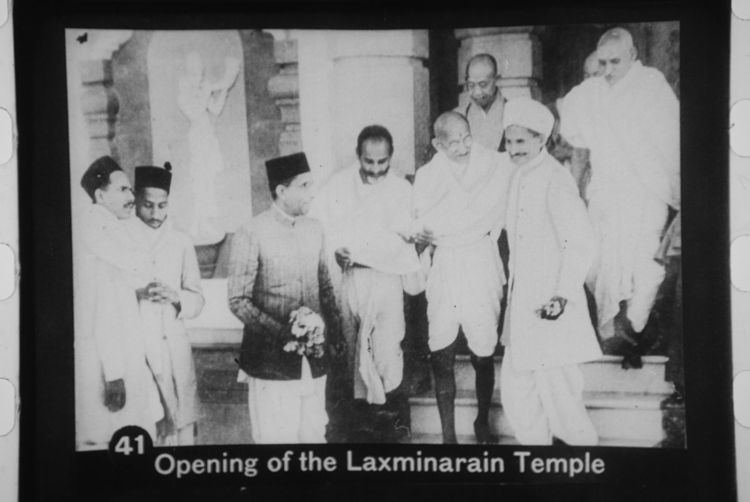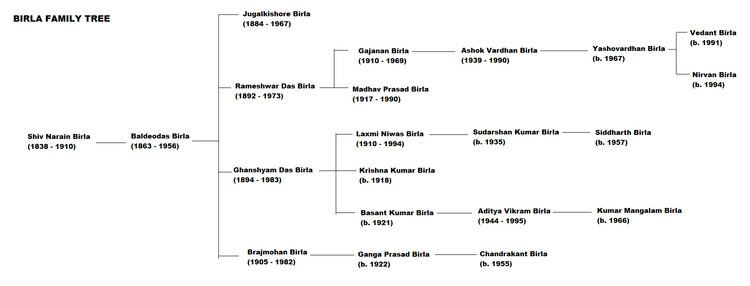Traditions Hindu | ||
Members 1.Shiv Narain Birla2.Baldeo Das Birla3.Jugal Kishore BirlaRameshwar Das BirlaGhanshyam Das BirlaBraj Mohan Birla4.Gajanan BirlaMadhav Prasad BirlaLakshmi Niwas BirlaKrishna Kumar BirlaBasant Kumar BirlaGanga Prasad Birla5.Ashok Vardhan BirlaSudarshan Kumar BirlaAditya Vikram BirlaChandra Kant Birla6.Kumar Mangalam BirlaYashovardhan BirlaSiddharth Birla | ||
Birla family
The Birla family is a family connected with the industrial and social history of India.
Contents
The main branch of the Birla family are descendants of Seth Shobharam, grandson of Seth Bhudharmal, a member of the Maheshwari Marwari community from Pilani in the westerly state of Rajasthan . Shiv Narain (1840–1909) was the son of Shobharam. Shiv Narain Birla, traded in cotton and laid the foundation of the family's future business success by moving to Bombay in 1863 and establishing Shivnarayan Baldevdas, a trading house in Bombay in 1884. His son, Baldeo Das Birla moved to Calcutta set up Baldevdas Jugalkishor in 1887. Baldeo Das was succeeded by four sons – Jugal Kishore, Rameshwar Das, Ghanshyam Das and Braj Mohan.

Baldeo Das was awarded the Raibahadur title in 1917. In 1920 he retired from business and started living in Banares pursuing religious studies. In 1925 he was awarded the title of "Raja" by the government of Bihar and Orissa. He was awarded D. Litt. by Beneras Hindu University.

Ghanshyam Das Birla laid the foundation of his industrial empire by establishing GM Birla Company, trading in jute, in 1911. The First World War began in 1914 greatly increasing the demand for jute sacks. It is estimated that during the war, the Birla worth rose from Rs 20 lakh to 80 Lakh. In 1919, he became among the first group of Indian entrepreneurs to become owner of a Jute mill named Birla Jute. In the next few years he acquired several cotton mills. He later started several sugar mills. The publication Hindustan Times was co-founded by GD Birla in 1924 and fully acquired by him in 1933. Hindustan Motors was started in 1942. After India's independence in 1947 he started Grasim (Gwalior Rayon Silk Manufacturing, 1948) and Hindalco (Hindustan Aluminium Company 1958) among others.

Baldeo Das, as well his sons were among the key supporters of the swaraj movement led by Mahatma Gandhi, in addition to being dedicated Hindu activists. They were active supporters of the Banaras Hindu University founded by Pt. Madan Mohan Malaviya and were also financial supporters of activities initiated by Mahatma Gandhi. Mahatma Gandhi was requested to inaugurate the landmark Laxminarayan Temple in Delhi, and as asked by Gandhi, all Hindus, including harijans were welcomed.

In the few decades before India's independence, Indian merchants, including the Birlas, made successful attempts to enter and acquire industries in India which were once dominated by Scots from Britain. This became a part of Mahatma Gandhi's Swadeshi movement.
Birlas remained close to some of the leaders of India, like Sardar Patel after India's independence. As leading industrialists, they were often accused by the leftists of exploiting their workers and aspiring to be among the richest in the world. Still when E. M. S. Namboodiripad became the chief minister of Kerala (1957–59), as a result of the first elected Marxist government anywhere, Birlas were invited to establish a pulp factory there.
In recent past, the Birlas, as well as several other Indian industrialists have expanded overseas.
Philanthropy
Birla philanthropy began in the 1880s, when the Birla family donated over Rs.1 lakh for setting up goshalas (shelters for the protection of cows) in Kolkata. By early 1900, the Birla family began to support education, influenced by Pandit Madan Mohan Malaviya. They supported educational charities in Kolkata and in Mumbai teaming up with Jamnalal Bajaj. In 1918, the family established the first high school in Pilani which evolved into BITS Pilani, a prestigious institution which now has branches in Hyderabad, Goa and Dubai. They also opened a Sanskrit library in Benares and a library in Kolkata. It is well known for the financial support of Indian's freedom struggle and for building temples (see Birla Temple) in several major Indian cities.
The institutions founded by the Birlas include:
Birla values
In a letter, Ghanshaym Das offered this advice to Aditya (his grandson) when he was studying at MIT:
“eat only vegetarian food, never drink alcohol or smoke, keep early hours, marry young, switch-off lights when leaving the room, cultivate regular habits, go for a walk everyday, keep in touch with the family, and above all, don’t be extravagant.”GD Birla instructed his son Basant Kumar to 'never utilize wealth only for fun and frolic,' to 'spend the bare minimum on yourself,' and to deride 'worldly pleasures.'
This advice symbolised the ethic of the rising Marwari community, with restraint and austerity its defining attributes.
Birla Family ties
Although the Birlas are perceived as a single entity, the different branches of the family are now financially independent. However they have continued to maintain family relationships that go back to the times when "Birla Brothers" were an actual entity and Raja Baldevdas was still alive.
Both of GD Birla's wives died early because of tuberculosis (He remarried after the death of his first wife), a common affliction at that time. The families of his brothers Brij Mohan and Rameshwar Das Birla helped in raising his children. When Yash Birla's parents died in a plane crash, Priyamvada Birla, ("Badi Ma") helped take care of him.
It is reported that Kumar Mangalam Birla had dipped into his own resources to help his beleaguered relative Yash with his financial issues with creditors, in order to preserve the family name.
"Tata-Birla" word pair
For many decades the extreme wealth in India was associated with the Tatas and Birlas. The terms "Tata" and "Birla" are frequently mentioned in conjunction, signifying their prominence among Indian industrialists. For a period, the Dalmias, associated with the Dalmia-Sahu Jain group, were considered significant competitors, yet the Tatas and Birlas have consistently maintained their status as leading figures in Indian industry from 1939 to 1997, in contrast to the decline of other industrial groups.
A plan for development of India was developed by a group of industrialists in 1944, which was termed the Tata-Birla plan or the Bombay plan, which is said to have served as a blueprint for India's first five-year plan.
Two South India comedy movies Tata Birla Madhyalo Laila and Tata Birla use the word pair. It also occurs in some songs.
